Columbine shooters Eric Harris and Dylan Klebold were supposedly victimized outcasts who belonged to a "Trench Coat Mafia" bent on revenge — but none of it was true.
When Columbine High School seniors Dylan Klebold and Eric Harris murdered 12 students, one teacher, and ultimately themselves in an April 20, 1999 shooting in Littleton, Colorado, the media initially described them as victims of bullying and outcasts thirsty for revenge. They were allegedly members of a goth subculture known as the Trench Coat Mafia that fueled their hatred for mainstream society.

Jefferson County Sheriff’s OfficeThe media painted Columbine shooters Eric Harris and Dylan Klebold as bullied members of an outcast group known as the Trench Coat Mafia — but that wasn’t true.
But this narrative has since been proven false.
“Most of the initial reporting was wrong,” explained Dave Cullen, a journalist who spent a decade researching the school shooting and chronicled its aftermath. “We were so anxious to answer that burning question for you that we jumped to conclusions on tiny fragments of evidence in the first days, even hours.”
At the time, the Columbine High School massacre was the deadliest school shooting in the history of the United States. It changed everything from how the adults in the nation thought of their kids to how first responders approached similar such high-risk crises and how parents thought about violence in the media.
As such, there was a scramble on behalf of the public and media alike to make sense of the seemingly senseless killing. But those media reports were wrought with contention and misunderstanding, and consequently, a large portion of the immediate coverage on the massacre was actually inaccurate, including the narrative of the Trench Coat Mafia.

Wikimedia CommonsEric Harris and Dylan Klebold in the Columbine cafeteria during the shooting on April 20, 1999.
But the colorful myths and erroneous details in the supposed story of the shooting since the initial coverage are now firmly in place. And as school shootings spike nationwide to unprecedented levels, it’s time to root out the truth behind the motives of Dylan Klebold and Eric Harris and do away with myths like the Trench Coat Mafia once and for all.
Indeed, “Understanding what happened can help us try to prevent these things from happening again in the future,” Kirsten Kreiling, president of the Columbine Memorial Foundation said. “If you don’t understand history, you are doomed to repeat it.”
The Mythic Trench Coat Mafia
In the aftermath of the Columbine shooting, Harris and Klebold were presented by the media not only as members of the Trench Coat Mafia but as victims of bullying by the more popular members of their high school. This was supposedly the reason why they responded with such violence. But in reality, Harris and Klebold were not victims. They weren’t out for revenge against jock bullies or an entire school that had ostracized them.
Through extensive communication with the local Jefferson County Sheriff’s office, the FBI, and students alike, Cullen revealed that the two shooters were actually socially accepted teenagers who weren’t bullied — but they certainly weren’t “normal” teenagers either.

Columbine.WikiaDylan Klebold (left) and Eric Harris. Circa 1998-1999.
It was claimed that Harris and Klebold were members of the Trench Coat Mafia, a school group initially reported by the media to perpetuate violence and described as a “sick Goth subculture.” It was said that the Trench Coat Mafia admired guns, Nazis, the military, and rock singer Marilyn Manson.
But the Trench Coat Mafia was really a school community of harmless computer gamers who wore black trench coats.
Moreover, Cullen’s conversations with students and an analysis of police documents uncovered that Harris and Klebold were not, in fact, a part of the Trench Coat Mafia. They did not appear in any of the group’s annual photos and members of the actual Trench Coat Mafia graduated years before Klebold and Harris.
Both Harris and Klebold had their own circle of friends, with the latter even attending the school prom with a date on his arm in a limousine filled with a dozen classmates days before the shooting. Klebold also assisted in student theatrical productions and was a computer assistant.
Harris was described by his parents as athletic and he too enjoyed computer programming. He was a member of a video production group with the school’s Rebel News Network and worked in the school’s computer labs, too, but wasn’t a member of the Trench Coat Mafia. His parents said he was content to be alone, but was by no means a loner and did have his own group of friends.
“I don’t believe bullying caused Columbine,” said Jeff Kass, who reported on the event for Rocky Mountain News. “My reason for that is they never mentioned it in their diaries.”
Kass eventually penned his own tome on the subject — Columbine: A True Crime Story — and like Cullen, detailed the duo’s personal lives, which each strongly indicated potentially dangerous and suspicious activity long before April 20, 1999. None of this chilling foreshadowing had anything to do with the Trench Coat Mafia.
Ignored Warning Signs About Eric Harris And Dylan Klebold Before The Columbine Shooting
Despite being accepted members of their school community, Eric Harris and Dylan Klebold were far from normal in terms of their attitudes towards violence and society.
Cullen found that Harris had thoroughly voiced his bleak perspective on modern society on numerous occasions before the massacre. Harris allegedly found joy in manipulating people, lying to them, and expressed little to no empathy regarding their troubles.
“God I can’t wait till they die. I can taste the blood now…You know what I hate?…MANKIND!!!…kill everything,” Harris wrote in his notebook.
As for Harris’ partner, Cullen wrote, “Klebold is easier to comprehend, a more familiar type. He was hotheaded but depressive and suicidal. He blamed himself for his problems.”
A picture of a calculated killer, Harris, and a troubled young man, Klebold, appeared to be the more likely profile of the shooters to Cullen than victims-turned-aggressors.
Kass also got a hold of Klebold’s college application essay through a Freedom of Information Act request and found that the young killer was somewhat self-aware and made active attempts to make sense of himself and his life. Klebold acknowledged in the essay that he had made mistakes and had become part of a bad crowd during his sophomore and junior years. But that he completed a college application at all strongly indicated to Kass that Klebold at least considered living out a future.
Nonetheless, both Harris and Klebold gave their parents and local authorities a hefty supply of warning signs — which went largely unreported.
In 1998, Harris and Klebold were arrested for breaking into a Jefferson County vehicle and placed into a juvenile diversion program by authorities. Meanwhile, Klebold recorded depressing and alarming notes in a personal day planner. He wrote unrequited love letters, and described feeling alone and wanting to die. In November 1997, Klebold wrote that he wanted someone to buy him a gun so that he could kill himself with it.
Harris And Klebold Prepare For Bloodshed, Taking No Cues From The Trench Coat Mafia
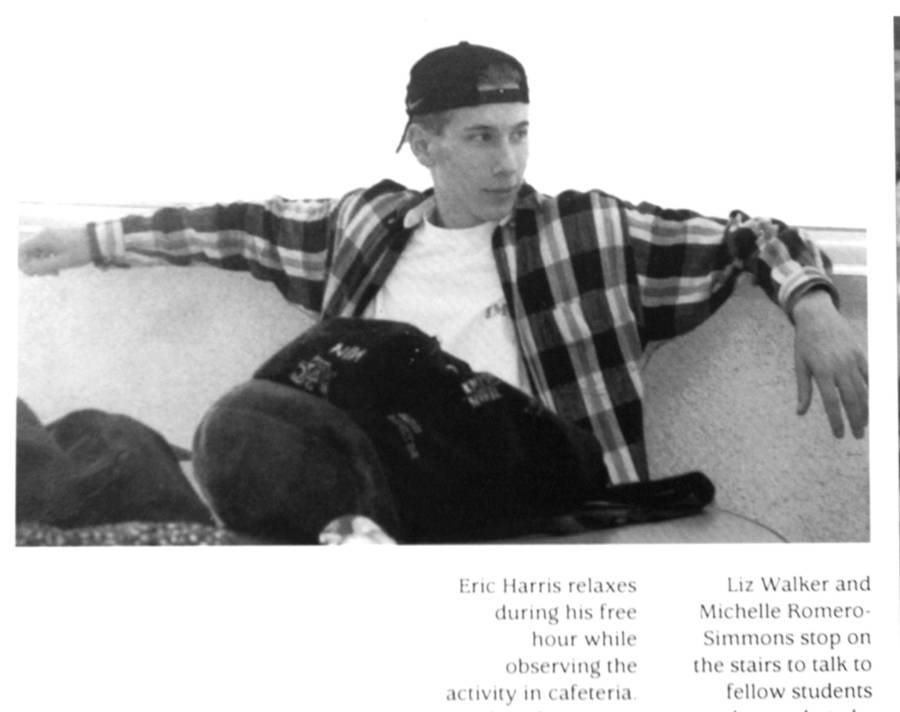
Photo by Rick Maiman/Sygma via Getty ImagesEric Harris in the Columbine yearbook. 1998-1999.
Klebold and Harris were busy making pipe bombs and quietly amassing a sizable arsenal of weapons which Harris recorded on his personal website. In 1998, junior Brooks Brown discovered his name on that very website and that Harris had threatened to murder him.
“When I first saw the Web pages, I was utterly blown away,” said Brown. “He’s not saying that he’s gonna beat me up, he’s saying he wants to blow me up and he’s talking about how he’s making the pipe bombs to do it with.”
When parents Randy and Judy Brown visited the Jefferson County Sheriff’s Office to alert them of this, they were told Harris already had a well-documented criminal file. Both Harris and Klebold were still on probation at this time for having broken into a car and for theft.
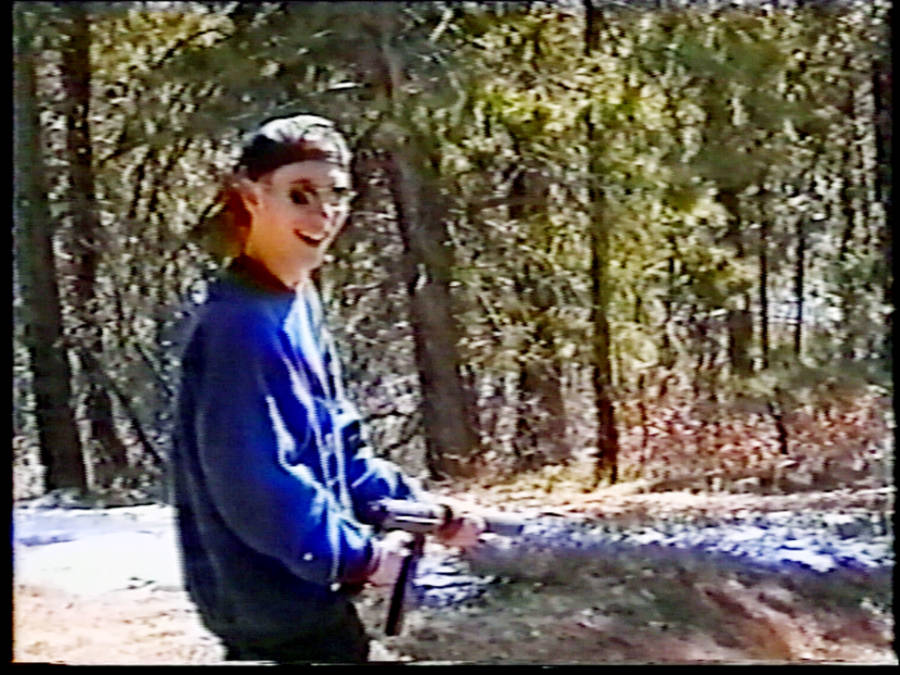
Jefferson County Sheriff’s Department via Getty ImagesEric Harris practices firing a weapon at a makeshift shooting range. March 6, 1999.
“I was utterly dumbfounded that they did nothing with the Web pages,” said Brooks Brown. “Eric was saying how he was gonna blow people up. ‘Hey, I’m making pipe bombs. I’ve got the designs for them on my Web site. I’m gonna kill these people. Here’s why.’ That’s a level beyond making a joke.”
A document obtained by CBS confirmed that investigators “met with Mrs. Judy Brown” and subsequently tried to get a warrant to search Harris’ home but they failed to do so. Oddly, a sheriff’s deputy reportedly found “a pipe bomb…consistent with the devices” Harris described on his website without having searched the young killer’s home.
Fellow Columbine student Nate Dykeman said that Harris and Klebold had shown off their weapons and bragged about them months before the shooting. Meanwhile, Devon Adams, a sophomore in 1998, also found herself mentioned on Harris’ website as an intended target.
Klebold even handed in an assignment that was so violent that his teacher later called it “the most vicious story she’d ever read.”
“The man unloaded one of the pistols across the fronts of four innocents…The…streetlights caused a visible reflection off of the droplets of blood…I understood his actions.”
By then, Klebold and Harris had added two sawed-off shotguns, a semiautomatic pistol, and a rifle to their stockpile.
What’s more, Joe Schallmoser and Howard Cornell, who were in charge of drafting a new set of security guidelines for the district following the shootings at Paducah, Kentucky and Jonesboro, Arkansas, reported that Columbine High school rejected implementing the safeguards just eight months before the attack.
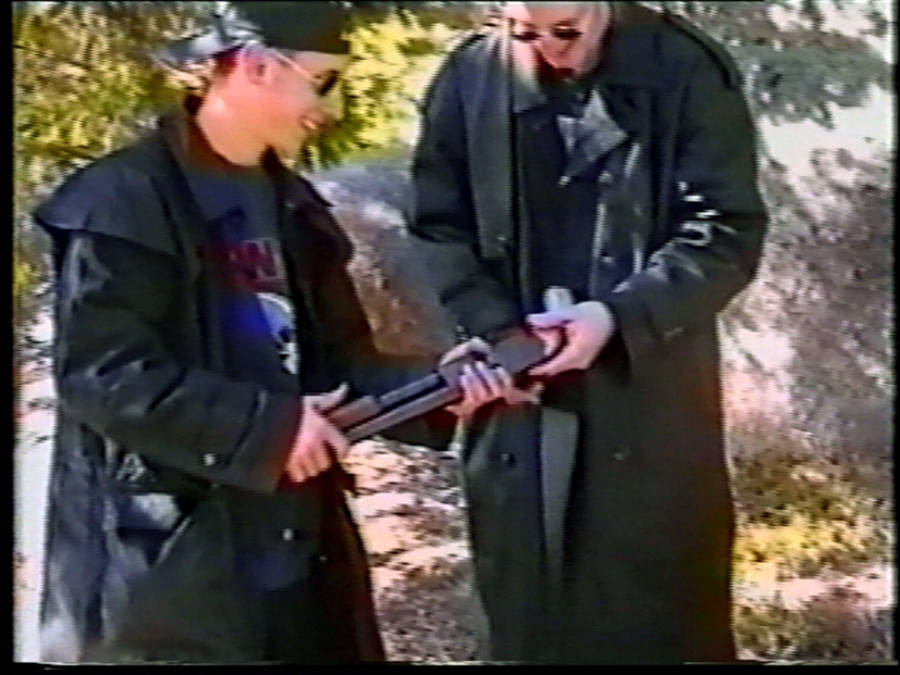
Jefferson County Sheriff’s Department via Getty ImagesEric Harris (left) and Dylan Klebold examine a sawed-off shotgun at a makeshift shooting range. March 6, 1999.
The guidelines would’ve required that the school notify parents and law enforcement about “a threat by any student” to “commit any act of violence.” Even though Columbine said they’d already discovered a potential threat — Harris — they added they didn’t need any assistance and thus did not take preemptive action against the young killer.
Why The Destruction At Columbine Was Supposed To Be Even More Far-Reaching
One of the more universally held beliefs since the shooting was that Harris and Klebold managed to successfully accomplish everything they set out to do that day.
However, this is at least halfway incorrect, as the pair’s primary intention was to set off bombs that would earn them comparisons to Timothy McVeigh and the destruction he wrought during the Oklahoma City bombing a few years prior.
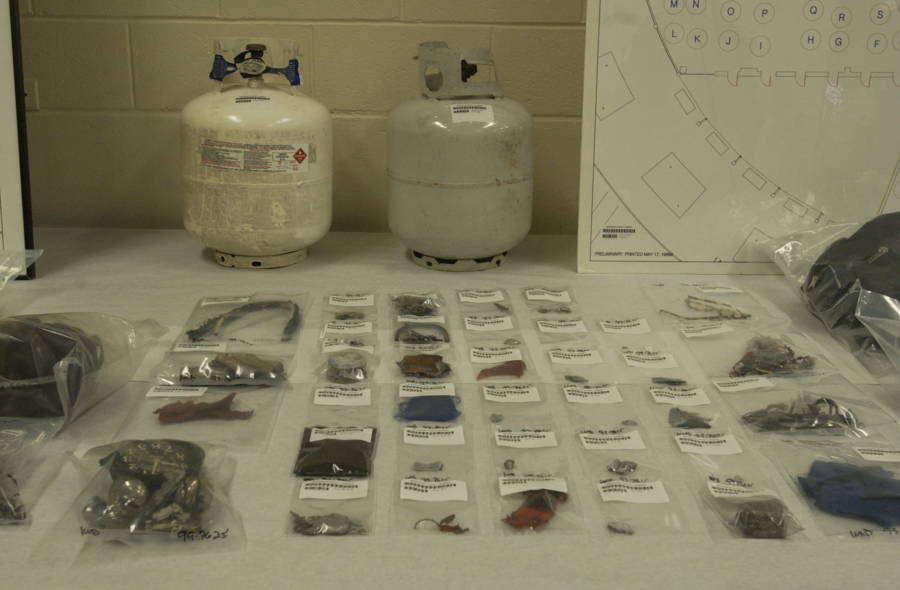
Craig F. Walker/The Denver Post via Getty ImagesEvidence, including the propane bombs, presented to the public five years after the shooting. Feb. 26, 2004.
Investigators eventually uncovered that fact after they read the journals left behind by Harris and Klebold. The statements found therein, of course, explained the two failed 20-pound propane bombs the pair carried into the cafeteria that morning.
The original plan was for the explosions to wreak havoc while Harris and Klebold waited near their cars in the parking lot to pick off anyone and everyone frantically exiting the building. The plan was to kill hundreds, with two massive homemade bombs putting things into motion — but their strategy failed, and the bombs didn’t go off.

Jefferson County Sheriff’s Office/Getty ImagesThe west entryway to Columbine, with flags marking points where bullet casings were found. April 20, 1999.
According to chief of investigations for the Jefferson County Sheriff’s Department, John Kiekbusch, the propane bombs failed because of their shoddy wiring, the Arizona Daily Sun reported. Only then, while waiting outside in frustration for the bombs to go off, did the two shooters re-enter the school and begin their gun-centric massacre before taking their own lives shortly after 12 p.m.
During their shooting spree, the pair even tried to set the cafeteria bombs off by firing at them but to no avail. It was shortly after that, when the SWAT team finally entered the building, that they killed themselves.
How The Columbine Massacre Caught Officials Off Guard
Most of the immediate coverage surrounding the shooting suggested that Harris and Klebold had taken the school hostage and made it difficult for the police to intervene.
In reality, it was simply a scenario that Jefferson County Police — or most of the country, for that matter — had never encountered. Columbine was “the first major hostage standoff of the cellphone age,” wrote Cullen, who added that police “had never seen anything like it.”
According to Cullen, though Columbine was never a hostage situation, the police approached the situation that way. He described how the police had “set up a perimeter, made sure that the gunmen didn’t escape and were waiting for their demands, essentially. And at one point also going into the building, about an hour into it, the first SWAT team went in.”

Steve Liss/The LIFE Images Collection/Getty ImagesFBI domestic terrorism squad agent Rich Price working on the Columbine case, with a chart of the cafeteria behind him.
The authorities had taken a defensive stance as opposed to an aggressive one which is utilized today and as such, mishandled the entire situation at Columbine. The notion that Harris and Klebold barricaded themselves inside, held students hostage and would’ve probably made demands had things not gone off the rails was a major misinterpretation of the scenario.
Why Mental Health Struggles, Not The Trench Coat Mafia, Were To Blame
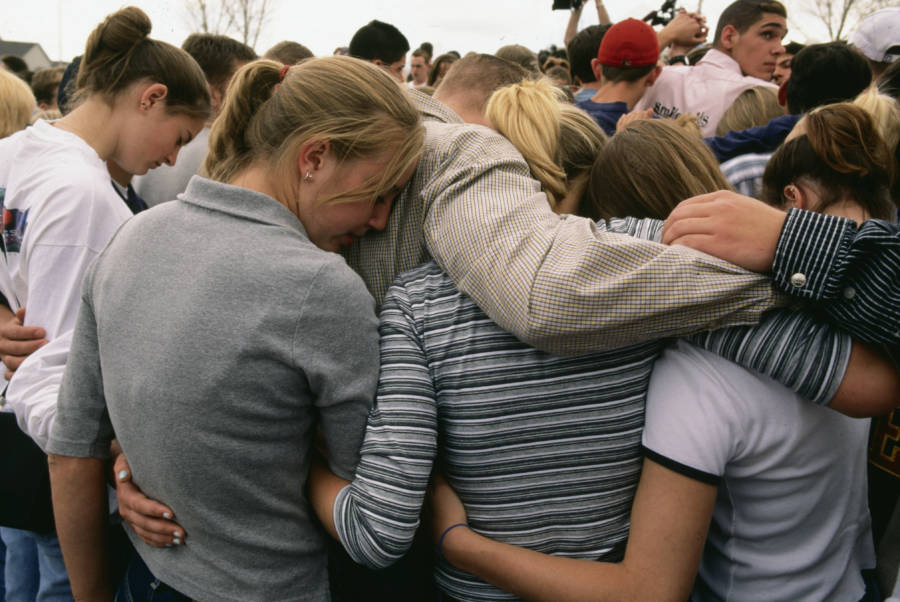
David Butow/Corbis via Getty ImagesStudents gather at a memorial for the victims. May 1999.
Eric Harris and Dylan Klebold weren’t social outcasts who were desperate to extoll vengeance on those who wronged them. Far more likely are the well-founded theories that the two teenagers were psychotic and clinically depressed, respectively. They weren’t outcast members of an angry group called the Trench Coat Mafia, but actually a calculating killer and troubled young man.
Perhaps the plain answer millions long for even decades after the Columbine High School massacre as to why the two boys committed the atrocious acts of violence they did has nothing to do with any Trench Coat Mafia and is instead likely best explained by one rational statement: They were mentally unwell.
“Oddballs are not the problem. They do not fit the profile. There is no profile. All the recent school shooters shared exactly one trait: 100 percent male. Aside from personal experience, no other characteristic hit 50 percent, not even close,” Cullen wrote.
Parents across the nation were desperate to make any semblance of sense of the tragedy and were eager to pin the terrifying behavior on an unorthodox subculture that the Trench Coat Mafia came to represent. No one wanted to believe that their children died for no reason and everyone wanted to believe that acts like this don’t come from just anyone, but a special kind of person, like a Trench Coat Mafia kind of person.
“Harris and Klebold planned for a year and dreamed much bigger,” said Cullen. “The school served as means to a grander end, to terrorize the entire nation by attacking a symbol of American life. Their slaughter was aimed at students and teachers, but it was not motivated by resentment of them in particular.”
“The path toward violence is an evolutionary one,” Cullen also wrote, “with signposts along the way.”
After this look at the Trench Coat Mafia and other myths from the Columbine school shooting, read the stories of two of the massacre’s victims, Rachel Scott and Cassie Bernall.






